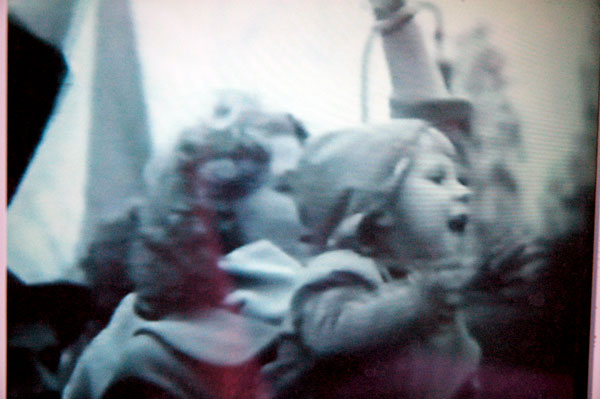
woman and child at the Wall, waving from West to East, 1961 (from a video on a stele at the Wall Memorial)
ADDENDUM: two images have been added within the original set below [on August 21, 2011]
I find myself nearly choking up as I write this. Yes, it's been a very long time since I've blogged anything on this site, but my emotion has nothing to do with having been absent so long from a "post". The reason I'm feeling a bit fragile right now is that I've been looking lately at a lot of images attached to the history of the Berlin Wall, memorialized yesterday exactly 50 years after it was installed. There are also my own memories of the Wall, and of Berlin, which begin in late spring of 1961, a few months before it even existed.
I returned to Berlin several times during the years the wall stood (but not often enough, as I still regret), and I've been back three times since it was torn down in 1989.
I suppose it's natural that at this time there should be more and more attention being paid to this piece of German and Western history, more perhaps than that currently being focused on the Nazi regime and its so much greater horror. At least two generations have been born since 1945, and Germans today are well-educated about the country's darker legacy, and fully-conscious of both the origins and the deeds of the twelve-year regime which ended in a Berlin bunker. Over 65 years later Germany is a very different country, the Germans a very different people, and almost no one survives today who could be said to have played an important role in the horrors which accompanied the first half of the last century.
The story of a divided Germany, a divided Berlin, however remains very much alive - and insufficiently known or documented. It's also the story of a divided people, and much of that division remains today. Both victims and tormentors survive, certainly in numbers sufficient to attract the curious social observer or documentarian.
Peter Schneider wrote in the Times two days ago that when he first began investigating the Wall 30 years ago his progressive friends thought his interest was weird, that the subject should be of interest to the Right: "The left held that the split was the price Germans had to pay for the crimes of the Third Reich." I can back him up: I was aware of something like that attitude among the Germans I knew decades ago.
Even today it seems there's not even the beginnings of a consensus about what happened between 1961 and 1989, or how it happened.
The Wall was one of the last remnants of a social and political struggle which began before 1933 and continued after 1945; it was a part of a much broader panorama of German history, and not just a product of an East/West Cold War (which had been germinating for several generations, not merely years). Much of the suspicion and passion of the struggle which created the wall is still with us, even if disguised and diffused.
I have been obsessed with German history all my life, and especially with the 25 years fateful years of the Weimar and National Socialist eras, but in the last decade or so I have become increasingly interested in the story of divided Germany, and especially divided Berlin (subjects my teachers would have called "current events"). Part of the reason for my fascination and hunger for information could be the fact that Barry and I have stayed, on our last two visits, in what had been East Berlin. There is nothing like affection for an adopted neighborhood - even a temporary one - and proximity to the subject to inspire interest in its history. But I'm sure I would find the subject fascinating even at a greater distance, and it offers virtually unlimited opportunities for discovery.
I took these pictures while we were in Berlin in May of this year. I'm using, welcoming, the anniversary of the Wall as the occasion and an inducement to publishing them here now. We stayed just one street away from the Berlin Wall Memorial, which begins roughly at the Nordbahnhof, on Gartenstrasse, and runs along Bernauerstrasse. The memorial service held yesterday was held one street in the other direction from our apartment. These photographs were captured in half-light, as we returned to our base on our first full day in the city.
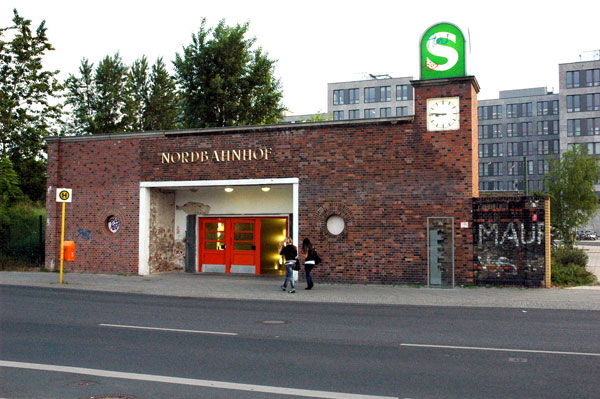
The S-Bahn stop, Nordbahnhof, closed between August 13,1961, the day the Berlin Wall went up, and September 1, 1990, is at the southwestern edge of the Bernauerstrasse section of the Wall Memorial; it includes an extensive, and evocative, "ghost stations" exhibit; this same building, by Richard Brademann, was constructed in 1936 and survived war (bombs, flooding), the postwar division of the city, and finally the Wall which destroyed its function

looking not unlike a street in Pompei, the archeological remains of Bergstrasse, showing the curb, paving stones and stumps of metal fence poles which were a part of the wall system
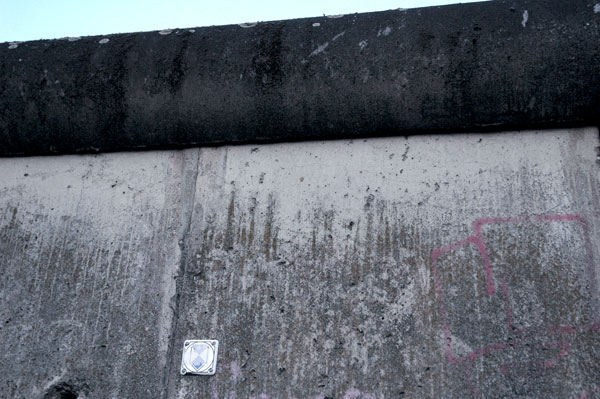
a section of one of the last surviving pieces of the Wall, on Bernauerstrasse, showing the small international Denkmalplakette, or monument emblem, established by the 1954 Hague Convention to identify "movable or immovable property of great importance to the cultural heritage of every people," to be protected in the event of armed conflict.
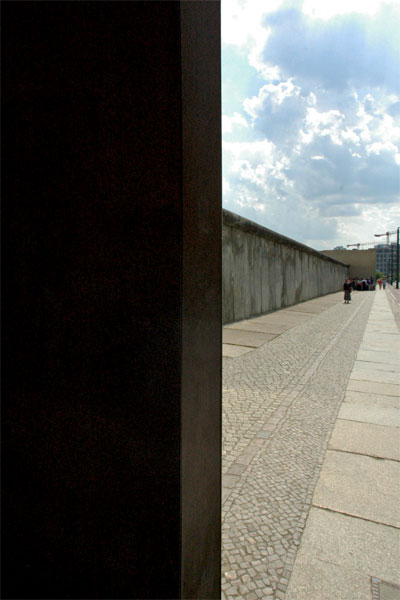
a view of one of a section of the concrete "Grenzmauer 75" (restored to its original condition), and in the left foreground the edge of the steel side wall designed by the memorial architects, the Stuttgart firm Kohlhoff & Kohlhoff, so that the polished surface of one of its sides would give an impression, artistically and optically, of the sheer length of the original barrier, most of which does not survive; the Gedenkstätte has not yet been completed in its entirety
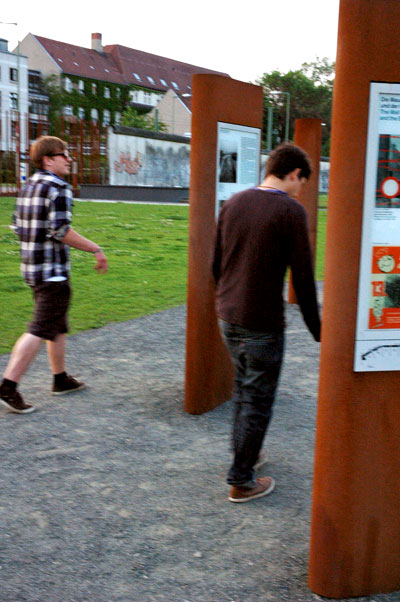
two Berlin youths visiting the still-under-construction Memorial Grounds on Bernauerstrasse, at dusk; we were near them while they watched one of the video screens imbedded in a stele, and when then-Bürgermeister Willy Brandt was seen speaking to the crowd at the wall, only three days after the closure (criticizing what he described as President Kennedy's empty rhetoric, asserting "Berlin expects more than words. It expects political action"), one of the two uttered respectfully - and affectionately, "Der Willy," in the way Germans often modify a friend's given name.

an image included in the wall of memorial materials located along Ackerstrasse, about one kilometer east of where this crowd of happy, stunned(?) East Berliners crossed to the West from Eberswalderstrasse into Bernauerstrasse the morning of November 11, 1989, through the first new street opening
More on the Wall, pictures and texts, from German sites, in English:
Germany marks 50 years (Deutsche Welle)
Before and After Photos of Germany's East-West Border (Der Spiegel)
'West Berliners Felt Abandoned and Powerless' (Der Spiegel)